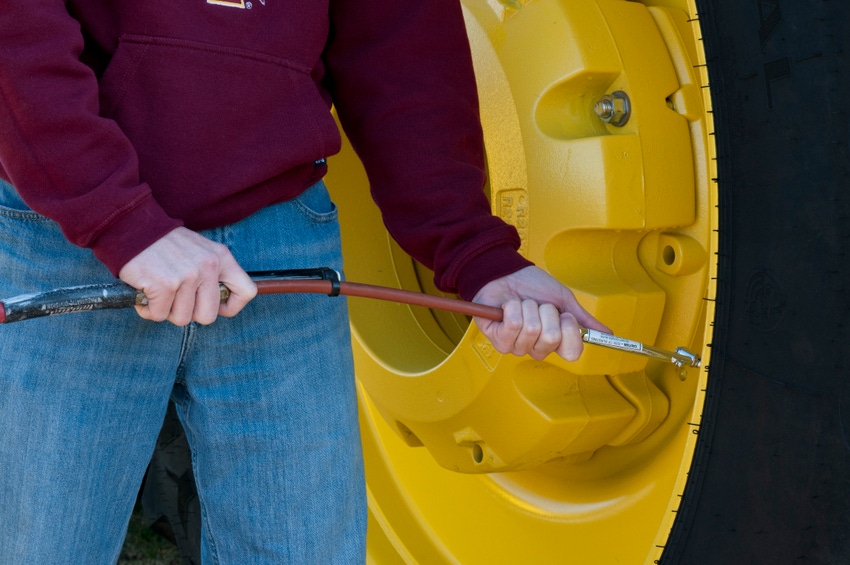
Limiting power hop through proper weight, ballast and tire inflation pressure
One factor that can severely inhibit productivity is power hop — a bouncing effect a tractor sometimes experiences when pulling a high draw-bar load. By understanding what causes power hop, however, farmers can better diagnose the problem and make minor adjustments to correct it.
January 11, 2012

In farming, productivity means profitability, and when your tractor isn’t performing like it should, it could mean lost dollars. One factor that can severely inhibit productivity is power hop — a bouncing effect a tractor sometimes experiences when pulling a high draw-bar load. By understanding what causes power hop, however, farmers can better diagnose the problem and make minor adjustments to correct it.
One of the major causes of power hop is unfortunately out of the farmer’s control — soil type. Power hop has been found to be most common in dry, loose soils, where traction is harder to obtain than in a high-moisture soil. Fortunately for farmers, all the other known causes of power hop can be addressed through adjustments to overall tractor weight, weight distribution and tire inflation pressures.
Overall tractor weight
Insufficient overall tractor weight for the horsepower is one of the major causes of power hop. Every tractor manufacturer has different recommendations on weight-to-horsepower ratios, but these recommendations generally fall somewhere between 100 lbs. per horsepower and 145 lbs. per hp. In other words, a 450-hp tractor should weigh somewhere between 45,000 and 65,250 lbs. Where your tractor falls within this range is dependent upon average speed during heaviest draft operations and whether the tractor is a mechanical front wheel drive (MFWD) or four wheel drive (4WD).
As a general rule, the slower the average speed of a tractor, the higher the weight-to-horsepower ratio should be. MFWD tractors generally have a higher recommended weight-to-horsepower ratio than 4WD tractors. So, a 4WD tractor traveling at high average speeds (5.5 mph or more) should fall within the lower end of the aforementioned weight-to-horsepower ratio spectrum, whereas a MFWD tractor traveling at low average speeds (4.5 mph or less) should fall within the higher end of the spectrum.
In order for a farmer to determine the most appropriate weight-to-horsepower ratio for his or her tractor, it’s best to consult with the tractor manufacturer, as each company’s recommendation will differ slightly based on type of tractor and average speed. If it is ultimately determined that the tractor is underweight, it is recommended that the farmer add cast ballast to achieve the proper ratio. Liquid ballast has been shown to increase tire stiffness, which can increase susceptibility to power hop.
Weight distribution
Even more important than overall tractor weight is the way the weight is distributed between front and rear axles. Without proper weight distribution, a tractor is far more susceptible to the bouncing and swaying motions of power hop. Similar to overall tractor weight, proper recommendations on weight distribution will again differ between MFWD and 4WD tractors.
The general rule for MFWD tractors without suspension is that 30 to 35% of overall tractor weight should remain on the front axle and 65 to 70% on the rear. For 4WD tractors, 51 to 55% of overall weight should remain on the front axle and 45 to 49% on the rear.
Exact recommendations may differ between tractor manufacturers and could be influenced slightly by type of implement. Again, it’s best practice for farmers to consult with the manufacturer to arrive at the best solution. One important thing to consider when adjusting weight distribution, however, is that adding weight to an axle also increases overall tractor weight. A farmer should be cognizant of this while making any adjustments.
Tire inflation pressures
Inflation pressures can also play a part in susceptibility to power hop. As a general rule, the stiffer the tire, the more susceptibility there will be to power hop. So, for optimum performance, it is recommended that farmers adjust their inflation pressures to the lowest possible pressure for the static load, as recommended in the Tire and Rim Association’s (TRA) inflation pressure tables.
Along the same lines of thought, tire size has been shown to influence susceptibility to power hop, simply because size dictates recommended inflation pressures. The larger the tire, the larger its air chamber, which means it can carry a load at lower inflation pressures than a smaller tire.
The lower the inflation pressure, the less stiff the tire, and the less susceptible the tractor will be to power hop. So, for optimum tire performance, it is recommended that farmers select the largest possible tire allowable for the equipment.
What to do if still experiencing power hop
If a farmer has followed all of the aforementioned guidelines for adjusting overall tractor weight, weight distribution and tire inflation pressures, but is still experiencing power hop, that farmer should consult with the tractor manufacturer for advice on next steps. These recommendations will often include raising front inflation pressures and/or removing weight from the front axle in order to shift the tractor’s center of gravity toward the rear of the machine.
Every scenario is unique and every machine is unique, which is why manufacturers’ recommendations will vary slightly based on factors such as tractor type, soil type and average speed.
Bottom line
Power hop is something that can inhibit productivity in the field, and although one of its main causes —soil type — is in the hands of Mother Nature, its other causes are in the control of the farmer. By ensuring overall tractor weight, weight distribution between the axles and tire inflation pressures are at the manufacturers’ recommended levels, farmers can limit the effects of power hop and remain productive in the field.
You May Also Like



